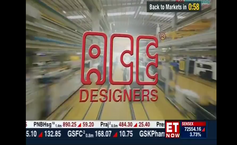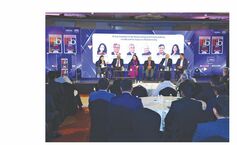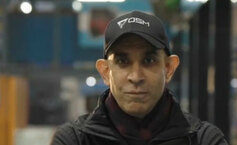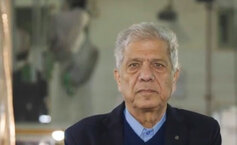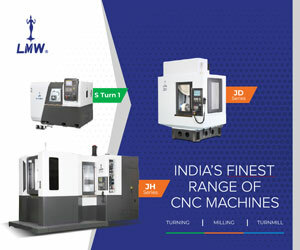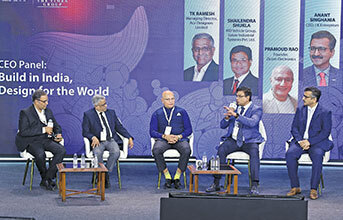
India's manufacturing sector has come a long way—from being a low-cost production hub to becoming a centre of engineering excellence. But the game is shifting. The global focus is now shifting beyond what is built to how it is designed.
A panel discussion was organised at the Festival of Manufacturing in Mumbai on the topic- ‘Build In India, Design For The World' where eminent panellists like TK Ramesh, Managing Director, Ace Designers Limited, Shailendra Shukla, MD Vehicle Group, Eaton Industrial Systems Pvt. Ltd., Pramoud Rao, Founder, Zicom Electronics and Anant Singhania, CEO, J K Enterprises participated. The panel was moderated by the Editor of ET Now B2B, Amit Shanbaug.
Starting the conversation, T K Ramesh, stated that India has indeed made significant progress in manufacturing, but when it comes to design-led innovation, we still have a long way to go.
"It's not just about technology or R&D—it's about necessity. Necessity is truly the mother of invention. One of the best examples is ISRO. Faced with global technology bans and limited resources, they achieved extraordinary feats through vision, leadership, and sheer determination," says T.K. Ramesh.
Drawing from his personal conversations with space research leaders, Ramesh believes that innovation thrives when there's hunger, purpose, and a real problem to solve.
"Today's young generation isn't just looking for job security—they want to make a difference. To truly become a global design powerhouse, we need leadership that inspires this zeal, identifies big problems worth solving, and backs them with the right investments and intent." He informs.
Manufacturing needs a mindset makeover
Speaking candidly, Pramoud Rao, Founder of Zicom Electronics, pointed out that India's manufacturing sector continues to grapple with both perception and policy challenges. "Manufacturing isn't drawing the best talent," he noted, adding that remote factory locations and the lack of social infrastructure make the sector less attractive, especially when compared to IT.
He also highlighted a critical gap in R&D investments. "India spends just 0.64% of its GDP on R&D, while China is at 2.5% and the US is at 3.5%. That's a huge difference— not just in percentage terms but in absolute value," Rao explained.
Referring to a recent article on Xiaomi's fully automated ‘dark factory' in China, he remarked, "They're producing one mobile every second with zero human intervention. No canteens, no holidays. It's mindboggling." According to him, the real issue is mindset. "We simply don't invest enough in R&D—and that, in my opinion, is the core problem."
Bridging the gap between aspiration and action
Speaking with optimism, Shailendra Shukla, MD Vehicle Group, Eaton Industrial Systems, acknowledged that India has come a long way in both manufacturing and design, but there's still ground to cover when compared to global giants like China and Germany. "We are distant from those countries in terms of scale and automation," he said, recalling a visit to a factory in China that manufactures the same product as an Indian facility—but with three times the capacity and less than a fiftieth of the manpower.
Still, he pointed to pockets of excellence in India. "A lot of design work for global products is already being done from India through GCCs. Our intelligent minds are solving global problems," he noted.
However, he cautioned that for India to truly compete, there needs to be a cultural shift. "We are often flexible when it comes to processes— but that mindset must change if we want to scale globally."
Building brands, not just products
While Indian companies have proven their mettle in manufacturing and global supply chains, evolving from OEM suppliers to globally recognised brands calls for a deeper push into innovation and scalability.
"We're doing some amazing things already," said Anant Singhania, recalling his recent test drive of a Mahindra electric vehicle and the seamless biometric experience of Digi Yatra. "It's mind-blowing," he added, pointing out that Indian innovation is indeed at par with the best globally.
But to earn brand recognition, he stressed the need for scale. "When I visited China, two factories were each making 500 million pieces of a product. We're just not there yet," he noted. What's needed is consistent value creation through original innovation. "The moment you bring in great value—not just manufacturing someone else's design—the branding will follow," he said. With the right focus, he believes Indian brands can move from the back end to front-of mind across the world.
As India aims to evolve from a global manufacturing hub to a design and innovation powerhouse, it must address challenges around mindset, investment in R&D, and scale. The journey demands not just engineering excellence but visionary leadership, cultural shifts, and bold intent. With the right push, Indian industry has the potential to not just build for the world—but to design, innovate, and lead it.







